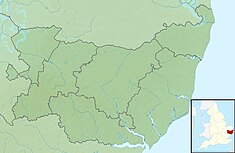Tranmer House
| Tranmer House | |
|---|---|
 | |
| Type | House |
| Location | Sutton Hoo, Woodbridge, Suffolk |
| Coordinates | 52°05′27″N 1°20′17″E / 52.0908°N 1.3381°E |
| Built | 1910 |
| Architect | John Shewell Corder |
| Architectural style(s) | Tudor Revival |
| Owner | National Trust |
Tranmer House is a country house in Sutton Hoo, Woodbridge, Suffolk, England, dating from 1910. The house is located on the Sutton Hoo Anglo-Saxon burial site, and in 1938 was the home of Edith Pretty. In June 1938, Pretty employed Basil Brown to undertake the excavation of a range of burial mounds on the estate, leading to Brown's discovery in May 1939 of a ship burial, "one of the most important archaeological discoveries of all time".[1] The house is now owned by the National Trust.
History and description
[edit]Tranmer House, then called Sutton Hoo House, was designed in 1910 by John Shewell Corder, an architect based in Ipswich, for a Suffolk artist, John Chadwick Lomax.[2] In 1926 the Sutton Hoo estate was bought by Edith Pretty and her husband, Frank, for £15,250.[3] Edith Pretty, born Edith Dempster in 1883, inherited a considerable fortune from her father upon his death in 1925.[4] Following Frank Pretty's death in 1934, Edith Pretty developed an interest in excavating the burial mounds that lay to the north-east of Tranmer House and engaged a local archaeologist, Basil Brown, to undertake two digs, in 1938 and 1939. During the second dig, Brown located the Anglo-Saxon ship burial site under Mound 1, "the largest Anglo-Saxon ship burial ever discovered".[5] The trove of treasure within made Sutton Hoo "the richest intact early medieval grave in Europe with a burial chamber full of dazzling riches".[6]
Edith Pretty died in 1942, having gifted the Sutton Hoo treasure to the British Museum.[a][7] The house was sold by her son's trustees in the late 1940s, and was owned by a number of local farming families until bought by the Tranmers. Following the death of Annie Tranmer, the house and the Sutton Hoo burial site were bequeathed to the National Trust in 1998. The Trust renamed the house in acknowledgement of the donation.[3]
James Bettley and Nikolaus Pevsner, in their Suffolk: East volume of The Buildings of England series, describe the architectural style of Tranmer as "Tudor".[2] The house now operates as a museum,[3] while the stable block, and original squash court,[2] form part of the Sutton Hoo Visitor Centre.[b][10]
In 2000, a second Anglo-Saxon cemetery was discovered beneath the rose garden.[11]
Footnotes
[edit]- ^ The then Prime Minister, Winston Churchill, offered Pretty a CBE in recognition of her generosity, but she declined.[7]
- ^ Tranmer House, and the wider Sutton Hoo site, are referenced in the 2021 film The Dig. The film, a dramatisation of the 1938/1939 excavations, used locations in Surrey for much of the filming, including for the burial site itself, and for Tranmer House, the exterior shots of which are of Norney Grange, a house in Shackleford designed by Charles Voysey.[8][9]
References
[edit]- ^ Bruce-Mitford 1977, p. 71.
- ^ a b c Bettley & Pevsner 2015, pp. 538–539.
- ^ a b c "Tranmer House at Sutton Hoo". National Trust.
- ^ "Obituary". The Chemical Trade Journal and Chemical Engineer. 76: 643. 1925. Retrieved 12 June 2017.
- ^ "The ghostly treasure ship of Sutton Hoo". National Geographic. 17 January 2017. Archived from the original on 17 February 2020. Retrieved 31 January 2021.
- ^ "The Anglo-Saxon ship burial at Sutton Hoo". The British Museum. Retrieved 31 January 2021.
- ^ a b Russell, Steve (29 July 2019). "Ghosts and treasure: The Edith Pretty Sutton Hoo story". East Anglian Daily Times.
- ^ Historic England. "Norney Grange (Grade II*) (1029515)". National Heritage List for England. Retrieved 31 January 2021.
- ^ "How the Sutton Hoo dig was recreated". Findthatlocation.com. Retrieved 31 January 2021.
- ^ "Sutton Hoo". National Trust. Retrieved 31 January 2021.
- ^ Fern, Christopher J. R. (2015). Before Sutton Hoo: The Prehistoric Remains and Early Anglo-Saxon Cemetery at Tranmer House, Bromeswell Suffolk. Bury St Edmunds: Suffolk County Council Archaeology Service. p. 1.
{{cite book}}: CS1 maint: date and year (link)
Sources
[edit]- Bruce-Mitford, Rupert (1977). "Obituary: Basil Brown" (PDF). Proceedings of the Suffolk Institute of Archaeology. 34 (1). Ipswich: 71.
- Bettley, James; Pevsner, Nikolaus (2015). Suffolk: East. Buildings of England. New Haven, US and London: Yale University Press. ISBN 978-0-300-19654-2. OCLC 995084088.
External links
[edit]- Sutton Hoo, at the National Trust website

